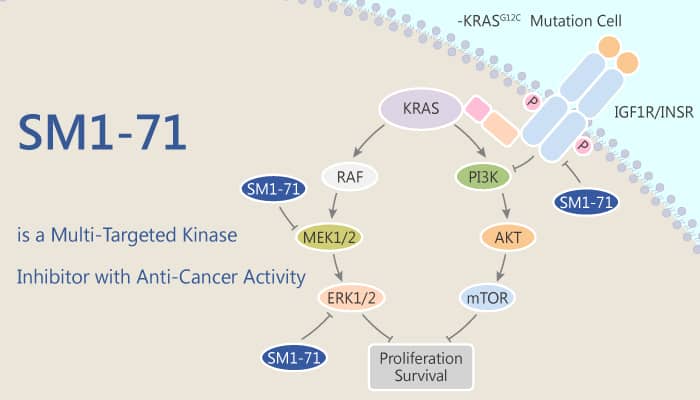In this article, we will introduce a potent TAK1 inhibitor, with a Ki of 160 nM. SM1-71 inhibits MEK1 activities with an IC50 of 142 nM. It also exhibits only weak activity against ERK2 with an IC50 of 1090 nM.

Additionally, SM1-71 has an acrylamide warhead in the ortho-position. At the same time, it exhibits off-target binding towards kinases other than TAK1 with a DFG-1 cysteine. This means it may be a multi-targeted probe to interrogate the cellular kinome.
Firstly, In order to distinguish covalent from reversibly bound targets, the authors chose SM1-71-R as a control compound. In a biochemical assay, SM1-71-R is a weaker inhibitor of kinases that previously demonstrated irreversible inhibition by SM1-71. SM1-71 shows 6 to 67-fold stronger inhibition on kinases such as GAK, MAP2K1, MAP2K2, MAPK1, LIMK1, and SRC than SM1-71-R. However, both SM1-71 and SM1-71-R show similar inhibition on reversibly bound kinases such as AURKA, PTK2 (FAK), TEC, IGF1R, and MET.
All those results show that SM1-71 enables it to bind targets in both a covalent and non-covalent manner.
It also can covalently inhibit GAK, YES1, SRC, AAK1, LIMK1, BMP2K, MAP2K2, MAP2K1 kinases. The IC50 values of 0.8 nM, 0.8 nM , 2 nM , 4.4 nM, 5.4 nM, 7.1 nM , 9.3 nM and 10.4 nM, respectively for above kinases.
Next, in vitro, the H23-KRASG12C NSCLC cell line is sensitive towards SM1-71, inhibiting the proliferation of H23-KRASG12C and Calu-6-KRASQ61K cells with IC50s of 0.4 and 0.3 μM, respectively. Additionally, SM1-71 induces potent cytotoxicity with nanomolar values for GR50 and negative GRmax values in eight of 11 cancer cell lines.
In conclusion, SM1-71, as a multitargeted kinase inhibitor, it has the potential to be a useful tool to discover kinase dependencies in cancer.
Reference:
[1]. Rao S, et, al. Cell Chem Biol. 2019 Jun 20; 26(6): 818-829.e9.
[2]. Tan L, et, al. Bioorg Med Chem. 2017 Feb 1; 25(3): 838-846.